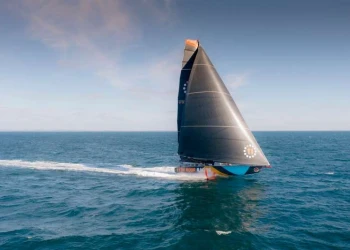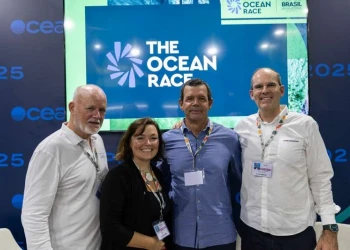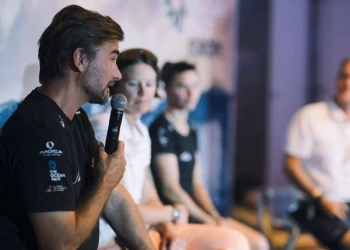
Why breaking a world record is a big deal
Why breaking a world record is a big deal
The connection between multiple world records and The Ocean Race is no coincidence. In the last 29 years a new distance record had been set 10 times, seven of which happened during an edition of the race. Now, in this race, two boats have added claims to the world record list.
Breaking the outright 24 hour distance record is a major achievement for which the stars need to align. Even then, the nature of setting this kind of record means that the accomplishment often comes as a surprise to the crew.
Most recently, delivering a blistering 24 hour run within the 3,000 nautical mile transatlantic Leg meant the start was a rolling affair. Clearly, there are no arches, flags or waypoints to mark the beginning of a run, instead the record often develops as a prolonged high speed sleigh ride starts to emerge. For Team Holcim-PRB and Team Malizia this is precisely what happened. But even then, it wasn’t that easy to know what was a record pace until the record was broken.
“It is remarkably rare to go in a straight line for 24 hours,” says former Ocean Race skipper Ken Read. And he should know. As skipper aboard Jim Clark’s 100ft super maxi Comanche he and his crew set a new 24 hour monohull record of 618.01 nautical miles in 2015. Raising the bar by 21.41 nautical miles on the previous best set by the Volvo 70 Ericsson 4 was an impressive achievement. In addition, the power, size and sophistication of this 100ft state of the art carbon rocket ship made it difficult to see how this distance could be improved. And for seven years it wasn’t.
But on Leg 5 of the 2023 edition of The Ocean Race two significantly smaller boats smashed it leaving the record at over 640 nautical miles (subject to WSSRC ratification).
“I read a quote from Malizia skipper Boris Herrmann the other day that I thought was exceptionally accurate,” Read continued. “He said, ‘Just having the fastest boat in the world is not even close to everything that's involved. You have to be really lucky.'
“He’s so right, because it's not just miles through the water, it's miles point to point in a straight line that count for the record but that’s not what you’re doing in reality. You're always in lifts, you're always in headers, you're always curving around a low pressure system and you're always heading for the next shift. It is remarkably rare to go in a straight line for 24 hours in a row. So, it’s about all those things plus having plenty of breeze, but not too much and flat-ish water but not too wavy, because when you're going fast these days waves are the enemy. It’s also about having a weather system that's moving along at the same pace you are. So, there is a ton of weather luck in there to be able to do this.”
For some record breakers, ensuring that such perfect conditions exist means playing the waiting game and sitting on standby until the time right. Yet, this makes it all the more impressive that so many of the 24 hour monohull distance records have been set during The Ocean Race when teams cannot choose when to set off on their mission.
“I don’t think it’s that surprising,” says Read. “First of all, that's when you push boats the hardest. You always think you're pushing the boat hard when you're practising but you never are because when you put somebody next to you, you will always push 10% harder, no matter what level you started at. So that's number one.
“And the second thing is that racing over this distance and time just increases the odds. When you go around the world and you sail somewhere between 28 and 50,000 miles, depending what the course is, you're just increasing the odds that at some stage you're going to trip over the right weather system.
“Add to this the fact that The Ocean Race has always been a breeding ground for the next fastest style of monohull you can get and it's no surprise to me that records get broken during racing. I think the really interesting part is that until recently, current formed an important part of the record breaking run. The Gulf Stream has often played a big part in this. But now, with modern machines like Comanche and especially with these foiling IMOCAs, it's about avoiding anything that can create waves and the Gulf Stream, or any sort of current, creates waves, So, now it's about getting out into flat water.
“What this race has done is show the world that IMOCAs, can set a new pace and I think it'll be interesting to talk to solo sailors like Charlie Darlin to find out how different the pace is when sailing fully crewed. Because we know that some of the equipment and systems aboard IMOCAs are fragile and now they are being taken to limits that they’ve never been to before. The key is learning how to do it without breaking the boat.
“So far, it’s taken 80 percent of the race around the world to establish this but now they seem to have figured it out and that’s fascinating.
“If I was sitting on the sidelines preparing for the Vendée Globe race I would be really nervous that these guys in The Ocean Race have made major steps forward on how to sail these boats. I’d be asking, can I catch up, can I figure it out before the start? So, for the rest of us that’s going to be really interesting to watch.”
Smashing the record is clearly a big deal, but this time the achievement looks like being even more important in the big scale of things.
24hour Distance records – Monohulls
1994 Intrum Justitia 64ft, Lawrie Smith, GBR, 428nm. 17.83kts (Leg 2 Whitbread race)
1997 Toshiba 64ft, Dennis Connor, USA, 434.4nm, 18.1kts (Whitbread race)
1997 Silk Cut 64ft, Lawrie Smith, GBR, 449.1nm. 18.71kts (Leg 2 Whitbread race)
2002 Illbruck 64ft, John Kostecki, USA, 484nm. 20.16kts (Leg 7 Volvo Ocean Race)
2003 MariCha IV 140ft, Robert Miller, GBR, 525.7nm, 21.9kts
2005 Movistar 70ft, Bouwe Bekking, NED, 530.19nm, 22.09kts (Training – Wellington to Cape Horn)
2005 ABN AMRO ONE 70ft, Mike Sanderson, NZL 546.14nm, 22.75kts (Leg 1 Volvo Ocean Race)
2006 ABN AMRO TWO 70ft, Sebastien Josse, FRA, 562.96 nm, 23.45kts (Leg 2 Volvo Ocean Race)
2008 Ericsson 4 70ft, Torben Grael BRA, 596.6nm, 24.85kt (Leg 1 Volvo Ocean Race)
2015 Comanche 100ft, Jim Clark/Ken Read USA, 618.01nm, 25.75kts.
Data – World Speed Sailing Record Council
The Ocean Race 2023 - Leg 5 24 hr distance claims*
2023 Holcim PRB – Kevin Escoffier – 640.90nm – 26.70kts
2023 Malizia 60ft – Boris Herrmann - 641.13nm – 26.71kts
Matthew Sheahan







